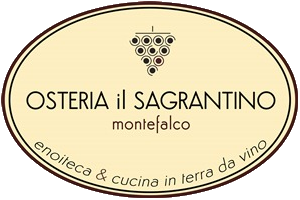Between October and November, as soon as the harvest is done, the hills around the towns of Montefalco, Bevagna, Gualdo Cattaneo and Giano dell’Umbria are vividly coloured an intense red with a unique hue. These are the rows and rows of the most famous varietal of Umbria, native to this small section of Italy: the Sagrantino.
This varietal gives its name to the red wine, the Sagrantino of Montefalco DOCG: a wine of great character with an interesting history to match.
The first official document to cite the name of this varietal dates back to the 16th century and can be found in the notarial archives in the city of Assisi. It is commonly believed that the Franciscan monks cultivated this grape in order to produce passito, a sweet wine, for religious ceremonies – hence the name Sagrantino, (sagra meaning sacred). Regarding the origins of the varietal, however, it seems likely to be the result of cultivating a selection of local clones. In any event, from the first half of the 14th century, local municipal statutes included laws and regulations intended to safeguard the vines and the wine they produced. Then, in 1540, a municipal decree officially established the date on which the harvest in Montefalco was to begin: this event is still honoured today, thanks to the Confraternita del Sagrantino, and every September locals and tourists gather in the piazza to witness the official inauguration of the harvest and for the reading of the historic proclamation. A curious character also lends himself to the history of the Montefalco Sagrantino: Cardinal Boncompagni of Perugia, who, in 1622 threatened severe sanctions against anyone caught in the act of cutting down a grape vine, with the maximum penalty being the gallows. At the beginning of the 19th century, in his ‘geographical, historical and statistical essay on the Papal territories’, the historian Serafino Calindri nominated the area around Montefalco as producing some of the best wines of the Papal State. Despite the national acclaim for its quality, in the following decades the Sagrantino varietal all but disappeared as a result of wars and the subsequent reconstruction efforts. It wasn’t until the 1960s, with the help of a dedicated and foreward-thinking group of winemakers, that the Sagrantino once again became the main varietal of the Montefalco area and eventually of the entire Umbria region. It was awarded DOC certification in 1979, then in1992 it was granted DOCG status, and in 1981 a consortium was established to safeguard the grape and its wine production.
It has only been in the last 30 years that Sagrantino has been produced as a dry wine, having previously only been a passito, or sweet wine.
In the early 2000s, a tasting event called Settimana Enologica was established to present to the general public the annual vintages of the Montefalco Sagrantino DOCG and the Montefalco Rosso DOC.This event later came to be called Enologica Montefalco and involves most of the local producers of these great wines.
The procedural guidelines of production requires the exclusive use of mono-varietal grapes, therefore 100% Sagrantino, for a maximum grape yield of 80 tonnes/hectare, and a maximum yield of grapes into wine of 65%. The minimum coefficient of acidity must be equal to 5 grams per litre, and the minimum quantity of alcohol must not be less than 13 %. One of the particular characteristics of the Montefalco Sagrantino is its method of refinement: in total it must be aged for 30 months, (calculated from the 1st of December), and for at least 12 months it must be aged in wood. The minimum net dry extract must be at 26 per thousand.
Sensory characteristics of Montefalco Sagrantino DOCG, dry vinification:
- visual analysis: intense ruby red, at times with violet highlights and tending towards grainy with aging.
- olfactory analysis: delicate with hints of blackberry. Spicy aroma and earthy with aging.
- nose-palate analysis : dry, balanced. When young, the tannins are strong. Very intense structure and long finish, (very long in aged wines). Persistent nose -palate.
The presence and reputation of the Montefalco Sagrantino DOCG in the wine scene, both in Italy and internationally, continues to expand. Its structure and its great capacity for aging, together with the variety and quality of aroma and flavour that characterise this wine, have put it on the list of the top five Italian winemakers: Brunello di Montalcino, Barolo, Amarone della Valpolicella and Taurasi. It is the perfect match with the highly flavoured dishes of Umbrian cooking, roasted meats and game stew.
The sweet version, passito, is the perfect accompaniment to the typical deserts of the area such as the “rocciata of Foligno” and many others. It is also widely used in the kitchen as a base for sauces for pasta, gnocchi and filets, or as a flavor enhancer for aged cheeses such as pecorino.
During a trip around Umbria, a visit to Montefalco is a must and of course, a tasting of the Sagrantino that gives the impression of sipping the nectar of this little corner of Italy.
Tourism in this area is not just about the beauty of the ancient villages, but also to a great extent about wine, the real emblem of the district thanks to the native Sagrantino.
You absolutely mustn’t miss a visit to Montefalco, a true medieval jewel in the midst of vineyards and olive groves.






